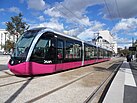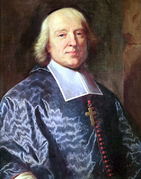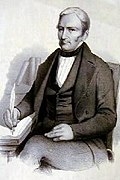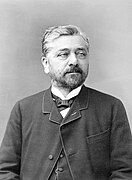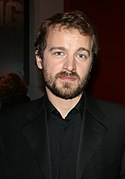Dijon
Dijon | |
|---|---|
Tramway de Dijon | |
| Coordinates:47°19′00″N5°01′00″E/ 47.316667°N 5.016667°E | |
| Country | France |
| Region | Bourgogne-Franche-Comté |
| Department | Côte-d'Or |
| Arrondissement | Dijon |
| Canton | Dijon-1,2,3,4,5and6 |
| Intercommunality | Dijon Métropole |
| Government | |
| • Mayor(2020–2026) | François Rebsamen[1](PS) |
| Area 1 | 40.41 km2(15.60 sq mi) |
| Population (2021)[2] | 159,346 |
| • Density | 3,900/km2(10,000/sq mi) |
| Demonym(s) | Dijonnais(masculine) Dijonnaise(feminine) |
| Time zone | UTC+01:00(CET) |
| • Summer (DST) | UTC+02:00(CEST) |
| INSEE/Postal code | 21231/21000 |
| Elevation | 220–410 m (720–1,350 ft) (avg. 245 m or 804 ft) |
| Website | www |
| 1French Land Register data, which excludes lakes, ponds, glaciers > 1 km2(0.386 sq mi or 247 acres) and river estuaries. | |
Dijon(UK:/ˈdiːʒɒ̃/,US:/diːˈʒoʊn/;[3][4]French:[diʒɔ̃])[a]is a city that serves as theprefectureof theCôte-d'Ordepartmentand of theBourgogne-Franche-Comtéregionin easternFrance.[5]As of 2017[update]thecommunehad a population of 156,920.
The earliest archaeological finds within the city limits of Dijon date to theNeolithicperiod.Dijon later became aRomansettlement namedDivio,located on the road betweenLyonand Paris. The province was home to theDukes of Burgundyfrom the early 11th until the late 15th centuries, and Dijon became a place of tremendous wealth and power, one of the great European centres of art, learning, and science.[6]
The city has retained variedarchitectural stylesfrom many of the main periods of the past millennium, including Capetian,Gothic,andRenaissance.Many still-inhabited townhouses in the city's central district date from the 18th century and earlier. Dijon's architecture is distinguished by, among other things,toits bourguignons(Burgundian polychrome roofs) made of glazedterracottatiles of various colours arranged in geometric patterns.
Dijon holds an International and Gastronomic Fair every year in the northern-hemisphere autumn. Dijon also hosts every three years the international flower showFlorissimo.Dijon has become famous forDijon mustard,which originated in 1856, when Jean Naigeon of Dijon substitutedverjuice,the acidic "green" juice of not-quite-ripe grapes, for vinegar in the traditional mustard recipe. Dijon is agreen citywith an important tertiary sector, as well as a regional economic centre with a diversified fabric, a traditional food-processing center (Dijoncrême de cassisand kir, gingerbread, Lanvin chocolate...) and a renowned pharmaceutical sector.
On 4 July 2015, UNESCO registered the historical centre of the city as aWorld Heritage site,as one of the components of the "Climats, terroirs of Burgundy"site, because of its historical importance in regulating the system of wine production in Burgundy.[7]
History
[edit]The earliest archaeological finds within the city limits of Dijon date to theNeolithicperiod. Dijon later became aRomansettlement calledDivio,which may meansacred fountain,located on the road fromLyonto Paris.Saint Benignus,the city's apocryphalpatron saint,is said to have introduced Christianity to the area before being martyred.
This province was home to theDukes of Burgundyfrom the early 11th until the late 15th century, and Dijon was a place of tremendous wealth and power and one of the great European centres of art, learning, and science. TheDuchy of Burgundywas key in the transformation of medieval times towardearly modern Europe.The Palace of the Dukes of Burgundy now houses the city hall and a museum of art.
In 1513, Swiss and Imperial armies invaded Burgundy and besieged Dijon, which was defended by the governor of the province,Louis II de la Trémoille.The siege was extremely violent, but the town succeeded in resisting the invaders. After long negotiations, Louis II de la Trémoille managed to persuade the Swiss and the Imperial armies to withdraw their troops and also to return three hostages who were being held in Switzerland. During the siege, the population called on theVirgin Maryfor help and saw the town's successful resistance and the subsequent withdrawal of the invaders as a miracle. For those reasons, in the years following the siege, the inhabitants of Dijon began to venerateNotre-Dame de Bon-Espoir(Our Lady of Good Hope). Although a few areas of the town were destroyed, there are nearly no signs of the siege of 1513 visible today. However,Dijon's museum of fine artshas a large tapestry depicting this episode in the town's history: it shows the town before all subsequent destruction (particularly that which occurred during the French Revolution) and is an example of 16th-century art.
A system of purified water for the citizens of Dijon was constructed byHenry Darcya quarter-century before Paris was so supplied.[8]
Dijon was also occupied by anti-Napoleonic coalitions in 1814, by the Prussian army in 1870–71, and byNazi Germanybeginning in June 1940, during WWII, when it was bombed by US Air Force B-17 Flying Fortresses,[9]before the liberation of Dijon by theFrench Armyand the French Resistance, 11 September 1944.
Geography
[edit]Dijon is situated at the heart of a plain drained by two small converging rivers: theSuzon,which crosses it mostly underground from north to south, and theOuche,on the southern side of town. Farther south is thecôte,or hillside, of vineyards that gives the department its name. Dijon lies 310 km (193 mi) southeast of Paris, 190 km (118 mi) northwest ofGeneva,and 190 km (118 mi) north ofLyon.
Climate
[edit]Dijon features anoceanic climate(Cfb) withcontinental influenceunder theKöppen climate classification.The city is highly influenced by its position far inland in Northeastern France. Thus, winters are cool to cold with moderate frosts at night and thawing conditions during the day while summers are warm to hot and humid with frequent thunderstorms.
| Town | Sunshine (hours/yr) |
Rain (mm/yr) |
Snow (days/yr) |
Storm (days/yr) |
Fog (days/yr) |
|---|---|---|---|---|---|
| National average | 1,973 | 770 | 14 | 22 | 40 |
| Dijon | 1,852.8 | 759.8 | 23.2 | 27.5 | 66.8[11] |
| Paris | 1,661 | 637 | 12 | 18 | 10 |
| Nice | 2,724 | 767 | 1 | 29 | 1 |
| Strasbourg | 1,693 | 665 | 29 | 29 | 56 |
| Brest | 1,605 | 1,211 | 7 | 12 | 75 |
| Climate data for Dijon (1991–2020 averages, extremes 1921−present) | |||||||||||||
|---|---|---|---|---|---|---|---|---|---|---|---|---|---|
| Month | Jan | Feb | Mar | Apr | May | Jun | Jul | Aug | Sep | Oct | Nov | Dec | Year |
| Record high °C (°F) | 16.5 (61.7) |
21.1 (70.0) |
24.9 (76.8) |
29.0 (84.2) |
34.4 (93.9) |
37.3 (99.1) |
39.5 (103.1) |
39.3 (102.7) |
34.2 (93.6) |
28.3 (82.9) |
21.6 (70.9) |
17.5 (63.5) |
39.5 (103.1) |
| Mean daily maximum °C (°F) | 5.6 (42.1) |
7.6 (45.7) |
12.5 (54.5) |
16.2 (61.2) |
20.0 (68.0) |
24.2 (75.6) |
26.7 (80.1) |
26.2 (79.2) |
21.7 (71.1) |
16.1 (61.0) |
9.7 (49.5) |
6.1 (43.0) |
16.1 (61.0) |
| Daily mean °C (°F) | 2.7 (36.9) |
3.8 (38.8) |
7.5 (45.5) |
10.7 (51.3) |
14.6 (58.3) |
18.5 (65.3) |
20.8 (69.4) |
20.4 (68.7) |
16.4 (61.5) |
11.8 (53.2) |
6.5 (43.7) |
3.4 (38.1) |
11.4 (52.5) |
| Mean daily minimum °C (°F) | −0.2 (31.6) |
0.0 (32.0) |
2.6 (36.7) |
5.2 (41.4) |
9.2 (48.6) |
12.8 (55.0) |
14.9 (58.8) |
14.6 (58.3) |
11.0 (51.8) |
7.6 (45.7) |
3.3 (37.9) |
0.7 (33.3) |
6.8 (44.2) |
| Record low °C (°F) | −21.3 (−6.3) |
−22.0 (−7.6) |
−15.3 (4.5) |
−5.3 (22.5) |
−3.3 (26.1) |
0.8 (33.4) |
2.8 (37.0) |
4.3 (39.7) |
−1.6 (29.1) |
−4.9 (23.2) |
−10.6 (12.9) |
−20.8 (−5.4) |
−22.0 (−7.6) |
| Averageprecipitationmm (inches) | 56.8 (2.24) |
42.9 (1.69) |
48.2 (1.90) |
57.5 (2.26) |
76.1 (3.00) |
65.8 (2.59) |
64.9 (2.56) |
62.0 (2.44) |
56.4 (2.22) |
73.6 (2.90) |
77.6 (3.06) |
61.6 (2.43) |
743.4 (29.27) |
| Average precipitation days(≥ 1.0 mm) | 10.6 | 8.4 | 9.2 | 9.1 | 10.3 | 8.9 | 7.8 | 7.9 | 7.9 | 9.8 | 11.1 | 11.3 | 112.3 |
| Averagerelative humidity(%) | 88 | 82 | 76 | 71 | 74 | 72 | 68 | 71 | 78 | 85 | 87 | 89 | 78 |
| Mean monthlysunshine hours | 60.8 | 95.1 | 159.8 | 193.7 | 215.5 | 240.3 | 256.9 | 239.7 | 190.9 | 118.0 | 66.5 | 52.9 | 1,890 |
| Source 1:Meteo France[12] | |||||||||||||
| Source 2: Infoclimat.fr (relative humidity 1961–1990)[13] | |||||||||||||
Sights
[edit]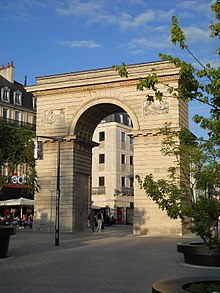
Dijon has a large number of churches, includingNotre Dame de Dijon,St. Philibert, St. Michel, andDijon Cathedral,dedicated to the apocryphal Saint Benignus, thecryptof which is over 1,000 years old. The city has retained variedarchitectural stylesfrom many of the main periods of the past millennium, including Capetian,GothicandRenaissance.Many still-inhabited townhouses in the city's central district date from the 18th century and earlier. Dijon architecture is distinguished by, among other things,toits bourguignons(Burgundian polychrome roofs) made of glazedterracottatiles of various colours arranged in geometric patterns.

Dijon was largely spared the destruction of wars such as the 1870Franco-Prussian Warand the Second World War, despite the city being occupied. Therefore, many of the old buildings such as thehalf-timberedhouses dating from the 12th to the 15th centuries (found mainly in the city's core district) are undamaged, at least by organized violence.
Dijon is home to many museums, including theMusée des Beaux-Arts de Dijonin part of the Ducal Palace (see below). It contains, among other things, ducal kitchens dating back to the mid-15th century, and a substantial collection of primarily European art, from Roman times through the present.
Among the more popular sights is theDucal Palace,thePalais des Ducs et des États de Bourgogneor "Palace of the Dukes and the States of Burgundy" (47°19′19″N5°2′29″E/ 47.32194°N 5.04139°E), which includes one of only a few remaining examples of Capetian period architecture in the region. Many art interested visitors flock to thePuits de MoïseorWell of Moses,a monumental sculpture byClaus Sluter.
The church of Notre Dame is famous for both its art and architecture. Popular legend has it that one of its stone relief sculptures, an owl (la chouette) is agood-luck charm:visitors to the church touch the owl with their left hands to make a wish. (The current carving was restored after it was damaged by vandalism in the night of 5 and 6 January 2001).
The Grand Théâtre de Dijon, built in 1828 and one of the main performing venues of theOpéra de Dijon,was declared amonument historiqueof France in 1975. It was designed by the Dijon-born architectJacques Cellerier(1742–1814) in theNeo-classicalstyle with an interior modelled on Italian opera houses.[14]
Transport
[edit]Roads
[edit]Dijon is located approximately 300 km (190 mi) southeast of Paris, about three hours by car along theA38andA6motorways. TheA31provides connections to Nancy, Lille and Lyon. TheA39connects Dijon withBourg-en-Bresseand Geneva, theA36withBesançon,MulhouseandBasel.
Water transport
[edit]TheCanal de Bourgognepasses through the heart of Dijon and creates a navigable route to Paris in the north-west via the riverYonne,a tributary of the riverSeine,and to theSaôneriver 25 km to the south-east. The canal joins the Saône atSaint-Jean-de-Losnewhich is the barging centre of France and Europe. In addition to the connection to the Atlantic via the Seine it has navigable water connections to the Mediterranean—via the Saône to the Rhône river at Lyon and further south (ultimately west to the Atlantic via theCanal du Midi)—Germany and central Europe—via theRhône-Rhine canal—plus west to the centre and river Loire via theCanal du Centre.These waterways were largely completed before the 19th century and were the main means of industrial transport until the railways began taking over in the mid-19th century. Today they form a water route for mostly pleasure craft between northern Europe and the south. For example the route through Dijon is popular with those sailing their boats from the United Kingdom to the Mediterranean.
Public transport
[edit]Trains
[edit]Dijon is an important railway junction for lines from Paris to Lyon andMarseille,and the east–west lines toBesançon,Belfort,Nancy,Switzerland, and Italy. TheDijon-Ville stationis the main railway station, providing service toParis-Gare de LyonbyTGVhigh-speed train(LGV Sud-Est), covering the 300 km (190 mi) in one hour and 40 minutes. For comparison, Lyon is 180 km (110 mi) away and two hours distant by standard train. The city of Nice takes about six hours by TGV and Strasbourg only 1 hour and 56 minutes via the TGV Rhin-Rhône.Lausannein Switzerland is less than 150 km (93 mi) away or two hours by train. Dijon has a direct overnight sleeper/couchette service to Milan, Verona and Venice by the operatorThello.Numerous regionalTER Bourgogne-Franche-Comtétrains depart from the same station. There is another railway station east of the city centre,Dijon-Porte-Neuve station,on the line to Is-sur-Tille and Culmont-Chalindrey.
Trams
[edit]Anew tram systemopened in September 2012. Line T1 is an 8.5 kilometres (5.3 miles) line with 16 stations running west–east from theDijon railway stationtoQuetigny.[15]Line T2 opened in December 2012, an 11.5 km (7.1 miles) north–south line with 21 stations running between Valmy and Chenôve.
Culture
[edit]Dijon holds its International and Gastronomic Fair every year in autumn. With over 500 exhibitors and 200,000 visitors every year, it is one of the ten most important fairs in France. Dijon is also home, every three years, to the international flower showFlorissimo.
Dijon has numerous museums such as theMusée des Beaux-Arts de Dijon,theMusée Archéologique,the Musée de la Vie Bourguignonne, theMusée d'Art Sacré,and theMusée Magnin.It also contains approximately 700 hectares of parks andgreen space,including theJardin botanique de l'Arquebuse.
Dijon is home to the prominent contemporary art centreLe Consortium,a fine-arts school (ENSA), as well as a number of art galleries like theFonds régional d'art contemporain,which holds a permanent collection including pieces by locally established artistYan Pei-Ming.
Apart from the numerous bars, which sometimes have live bands, some popular music venues in Dijon are: Le Zenith de Dijon, La Vapeur, l'Espace autogéré des Tanneries and l'Atheneum.
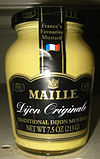
Dijon mustardoriginated in 1856, when Jean Naigeon of Dijon substitutedverjuice,the acidic "green" juice of not-quite-ripe grapes, for vinegar in the traditional mustard recipe.[16]In general, mustards from Dijon today contain white wine rather than verjuice. Dijon mustard is not necessarily produced near Dijon, as the term is regarded asgenericizedunderEuropean Union law,so that it cannot be registered forprotected designation of originstatus.[17]Most Dijon mustard (brands such asAmoraorMaille) is produced industrially and over 90% of mustard seed used in local production is imported, mainly from Canada. In 2008, Unilever closed its Amora mustard factory in Dijon. Dijon mustard shops sell exotic or unusually-flavoured mustard (fruit-flavoured, for example), often sold in decorative hand-paintedfaience(china) pots.
Burgundy is a world-famous wine growing region, and notable vineyards, such asVosne-RomanéeandGevrey-Chambertin,are within 20 minutes of the city center. The town's university boasts a renowned enology institute. The road fromSantenayto Dijon is known as the "route des Grands Crus",where eight of the world's top ten most expensive wines are produced, according to Wine Searcher.[18]
The city is also well known for itscrème de cassis,or blackcurrantliqueur,used in the drink known as "Kir",named after former mayor of DijoncanonFélix Kir,a mixture of crème de cassis with white wine, traditionallyBourgogne Aligoté.
Dijon is home toDijon FCO,a football club with a men's team competing in the Championnat National anda women's teamcompeting in theDivision 1 Féminine.Dijon has a its own (Pro A) basketball club,JDA Dijon Basket.ThePalais des Sports de Dijonserves as playground for the team and hosted international basketball events such as the FIBAEuroBasket 1999in the past. Dijon is home to theDijon Ducsice hockey team, who play in theMagnus League.[19]To the northwest, therace trackofDijon-Prenoishosts variousmotor sportevents. It hosted theFormula 1French Grand Prixon five occasions from 1974 to 1984.
Colleges and universities
[edit]- Dijon hosts the main campus of theUniversity of Burgundy
- École nationale des beaux-arts de Dijon
- European Campus ofSciences Po Paris
- Agrosup Dijon
- Burgundy School of Business
Population
[edit]
|
| |||||||||||||||||||||||||||||||||||||||||||||||||||||||||||||||||||||||||||||||||||||||||||||||||||||||||||||||||||||
| ||||||||||||||||||||||||||||||||||||||||||||||||||||||||||||||||||||||||||||||||||||||||||||||||||||||||||||||||||||||
| Source: EHESS[20]and INSEE (1968–2021)[21] | ||||||||||||||||||||||||||||||||||||||||||||||||||||||||||||||||||||||||||||||||||||||||||||||||||||||||||||||||||||||
Personalities
[edit]- John the Fearless(1371–1419), Duke of Burgundy
- Philip the Good(1396-1467), Duke of Burgundy
- Isabella of Portugal(1397-1471), Duchess of Burgundy
- Charles the Bold(1433–1477), Duke of Burgundy
- Claude-Louis Navier,mechanical engineer & physicist
- Jean Le Fèvre (canon)(1493–1565), lexicographer
- Charles Poisot(1822–1904), musicologist
- Edmond Debeaumarché(1906–1959),hero of the French Resistance
- Christian Allard(b. 1964),Member of the Scottish Parliament[22]
- Claude Balbastre(1724–1799), composer
- Cécile Bart(born 1958), artist
- Jean-Marc Boivin(1951–1990), extreme sports specialist
- Fabrice Brégier(born in 1961), businessman, Chief Operating Officer ofAirbus
- Antoine Bret(1717–1792), French playwright
- Jacques-Bénigne Bossuet(1627–1704), bishop and theologist
- Madjid Bougherra(b. 1982),Rangers F.C.footballer
- Thierry Caens(b. 1958), classical trumpeter
- Laurent Chambertin(b. 1966), volleyball player
- Jane Frances de Chantal(Jeanne–Françoise Frémiot, baronne de Chantal, 1572–1641), founder of theVisitation Order
- François Chaussier(1746–1828), physician
- Anne-Caroline Chausson(b. 1977), Olympic medalist in cycling
- Bernard Courtois(1777–1838), discoverer of the element iodine
- Charles Joseph Minard(1781–1870), civil engineer and first information graphics
- Henry Darcy(1803–1858), engineer
- Jean-Jacques-Joseph Debillemont(1824–1879), conductor and operetta composer
- Alexandre Gustave Eiffel(1832–1923), engineer and architect
- Eugène Foveau(1886–1957), classical trumpeter
- Roger Guillemin(1924–2024), Nobel laureate in Physiology and Medicine
- Hermine Horiot(born 1986), classical cellist
- Jules Jacquot d'Andelarre(1803-1885), politician
- Claude Jade(1948–2006), actress
- Joseph Jacotot(1770–1840), educational philosopher
- François Jouffroy(1806–1882), sculptor
- Henri Legrand du Saulle(1830–1886), psychiatrist
- Jean-Baptiste Gondelier(1792–1852), playwright
- Jean-Pierre Marielle(1932–2019), actor
- Julien Pillet(b. 1977), Olympic medalist insabrefencer
- Nicolas Quentin(d. 1636), historical painter
- Jean-Philippe Rameau(1683–1764), composer
- Claude-François-Marie Rigoley,comte d'Ogny, (1756–1790), cellist
- François Rude(1784–1855), sculptor
- Elizabeth of the Trinity(Marie–Élisabeth Catez, 1880–1906),Carmelitenun and religious writer
- Vitalic(born as Pascal Arbez in 1976),electronic musicartist
- Alban Lenoir(born in 1980), actor, stuntman, screenwriter.
Twin towns - sister cities
[edit] Białystok,Poland, since 1996
Białystok,Poland, since 1996 Cluj-Napoca,Romania
Cluj-Napoca,Romania Mechelen,Belgium
Mechelen,Belgium Chefchaouen,Morocco
Chefchaouen,Morocco Dakar,Senegal
Dakar,Senegal Dallas,United States, since 1957
Dallas,United States, since 1957 Guimarães,Portugal
Guimarães,Portugal Mainz,Germany, since 1958
Mainz,Germany, since 1958 Prague 6,Czech Republic
Prague 6,Czech Republic Reggio Emilia,Italy, since 1963
Reggio Emilia,Italy, since 1963 Skopje,North Macedonia, since 1961
Skopje,North Macedonia, since 1961 Volgograd,Russia, since 1960
Volgograd,Russia, since 1960 York,United Kingdom, since 1953
York,United Kingdom, since 1953
See also
[edit]Notes
[edit]- ^Translated in other notable and relevant languages:
- ‹See Tfd›German:Dision[ˈdɪzi̯oːn]
(dated) - Italian:Digione[diˈdʒoːne]
- Latin:DiviōorDiviodūnum[dɪwɪ.ɔˈduːnũː]
- Lombard:Digion[diˈdʒũː]
- ‹See Tfd›German:Dision[ˈdɪzi̯oːn]
References
[edit]- ^"Répertoire national des élus: les maires"(in French). data.gouv.fr, Plateforme ouverte des données publiques françaises. 13 September 2022.Archivedfrom the original on 28 June 2020.Retrieved24 November2022.
- ^"Populations légales 2021"(in French).The National Institute of Statistics and Economic Studies.28 December 2023.
- ^Wells, John C.(2008).Longman Pronunciation Dictionary(3rd ed.). Longman.ISBN978-1-4058-8118-0.
- ^Jones, Daniel(2011).Roach, Peter;Setter, Jane;Esling, John(eds.).Cambridge English Pronouncing Dictionary(18th ed.). Cambridge University Press.ISBN978-0-521-15255-6.
- ^"Destination Dijon and Burgundy - Palais des Congrès".dijon-congrexpo.Archivedfrom the original on 28 December 2017.Retrieved19 June2017.
- ^"Dukes of Burgundy, the History of Burgundy, France - burgundytoday".burgundytoday.Archivedfrom the original on 30 April 2012.Retrieved19 June2017.
- ^mondial, UNESCO Centre du patrimoine."Les Climats du vignoble de Bourgogne".UNESCO Centre du patrimoine mondial(in French).Archivedfrom the original on 26 April 2020.Retrieved13 April2023.
- ^Freeze, R. Allan (1994). "Henry Darcy and the Fountains of Dijon".Ground Water.32(1): 23–30.Bibcode:1994GrWat..32...23F.doi:10.1111/j.1745-6584.1994.tb00606.x.ISSN0017-467X.
- ^"Bombing of Dijon, France".U.S. Air Force.Archivedfrom the original on 2 February 2014.Retrieved19 January2009.
- ^Paris,Nice,Strasbourg,Brest
- ^"Normales climatiques 1981-2010: Île de Dijon".lameteo.org.Archivedfrom the original on 4 October 2022.Retrieved14 June2022.
- ^"Dijon–Longvic (35)"(PDF).Fiche Climatologique: Statistiques 1991–2020 et records(in French). Meteo France.Archived(PDF)from the original on 7 July 2022.Retrieved21 July2022.
- ^"Normes et records 1961–1990: Dijon–Longvic (21) – altitude 36m"(in French). Infoclimat. Archived fromthe originalon 3 March 2016.Retrieved21 July2022.
- ^Base Mérimée:Théâtre, Dijon,Ministère français de la Culture.(in French).
- ^"Pioneering PPP energises Dijon tram".Railway Gazette. 21 July 2010.Archivedfrom the original on 24 September 2012.Retrieved25 June2012.
- ^Jack E. Staub, Ellen Buchert (18 August 2008).75 Exceptional Herbs for Your Garden.Gibbs Smith. p. 170.ISBN9781423608776.
- ^"SCADPlus: Protection of Geographical Indications and Designations of Origin".Europa (web portal).Archived fromthe originalon 10 March 2009.Retrieved5 May2009.
- ^"World's Top 50 Most Expensive Wines".Wine-Searcher.Archivedfrom the original on 15 February 2014.Retrieved5 May2009.
- ^Dijon Hockey Club."Duc's Official Website"(in French). Archived fromthe originalon 2 February 2010.Retrieved1 October2010.
- ^Des villages de Cassini aux communes d'aujourd'hui:Commune data sheet Dijon,EHESS(in French).
- ^[1]Archived30 June 2024 at theWayback Machine,INSEE
- ^"Christian Allard – MSPs: Scottish Parliament".Archived fromthe originalon 1 February 2014.Retrieved16 May2013.
- ^"Villes partenaires".dijon.fr(in French). Dijon.Archivedfrom the original on 16 September 2017.Retrieved12 November2019.
Further reading
[edit]- "Dijon",A handbook for travellers in France,London: John Murray, 1861,OL24627024M
- C.B. Black (1876),"Dijon",Guide to the north of France,Edinburgh: Adam and Charles Black
- "Dijon",Northern France,Leipsic: Karl Baedeker, 1899,OCLC2229516,OL24872324M
External links
[edit] Dijontravel guide from Wikivoyage
Dijontravel guide from Wikivoyage- .Encyclopædia Britannica.Vol. 8 (11th ed.). 1911. pp. 269–270.
- Official website
 (in French)
(in French) - Dijon Tourism - Dijon Metropole Tourist Office






